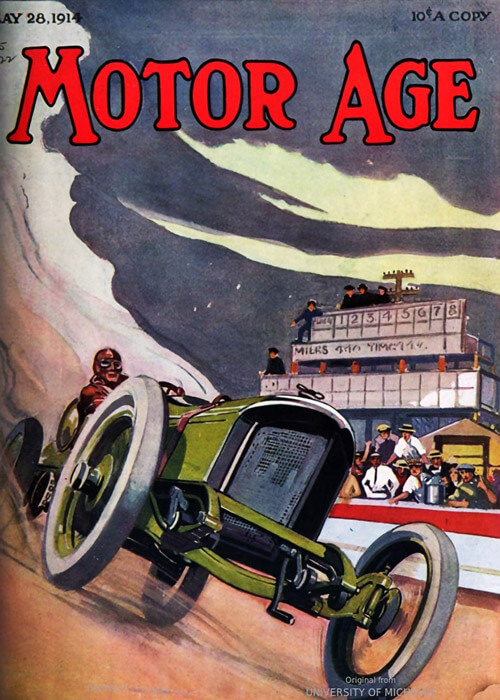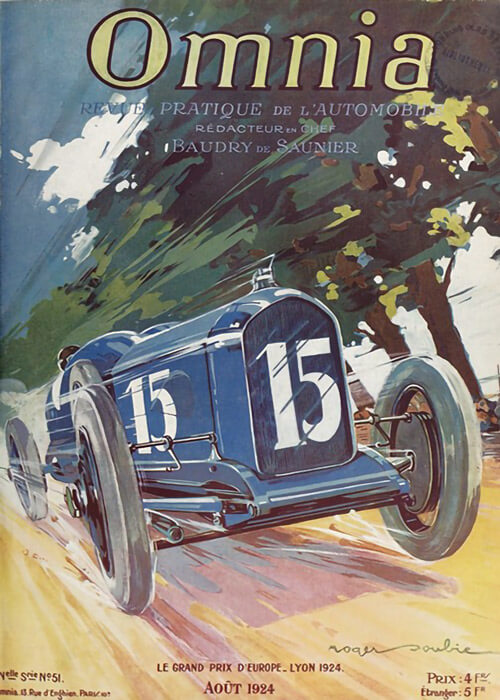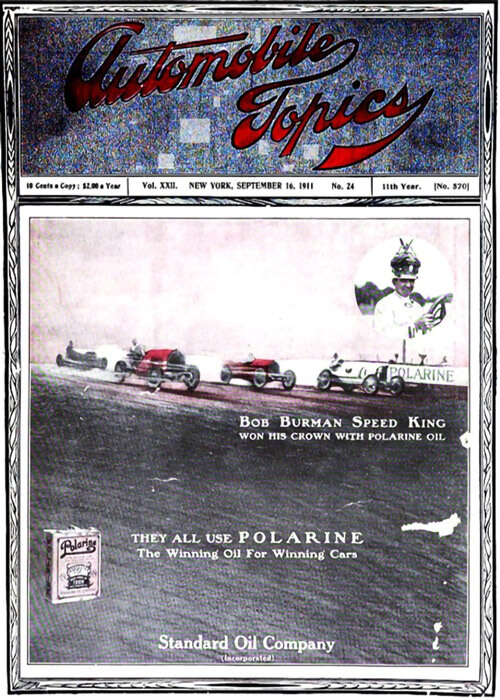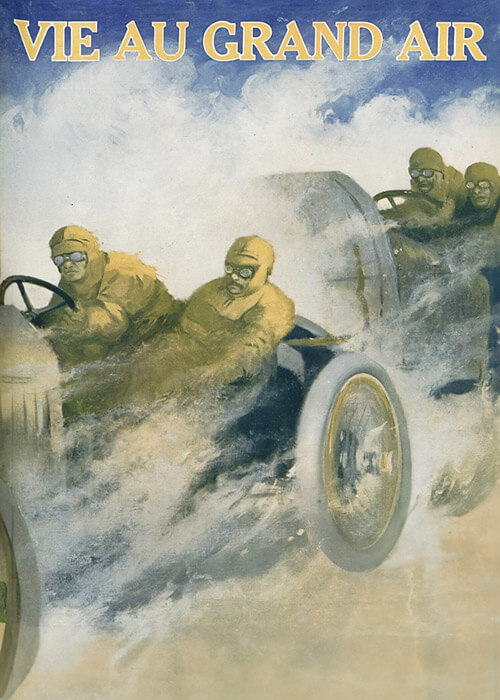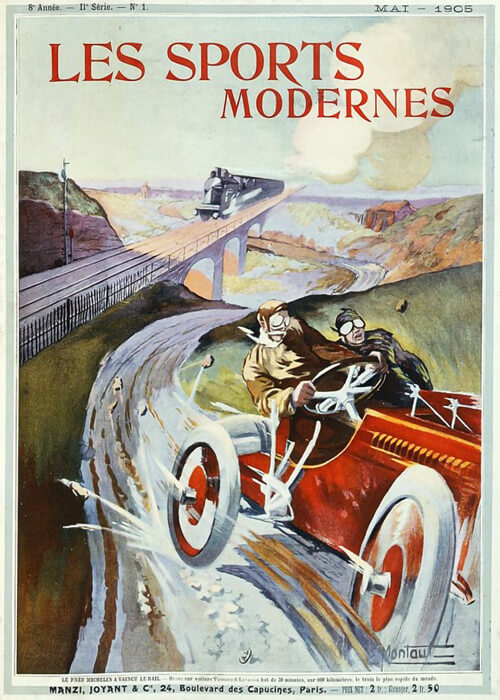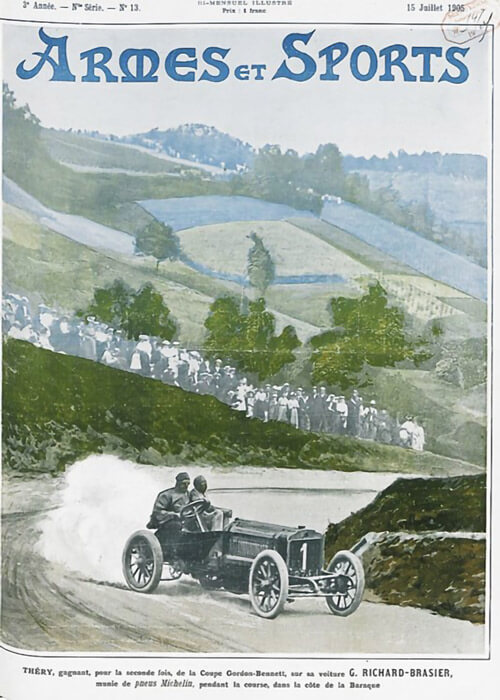This article first descibes briefly the results of the previous Targa Florio’s. In this 1922 Targa Florio, the small engine capacities wer a surprise, with exception of the winner: Count Masetti in Mercedes.
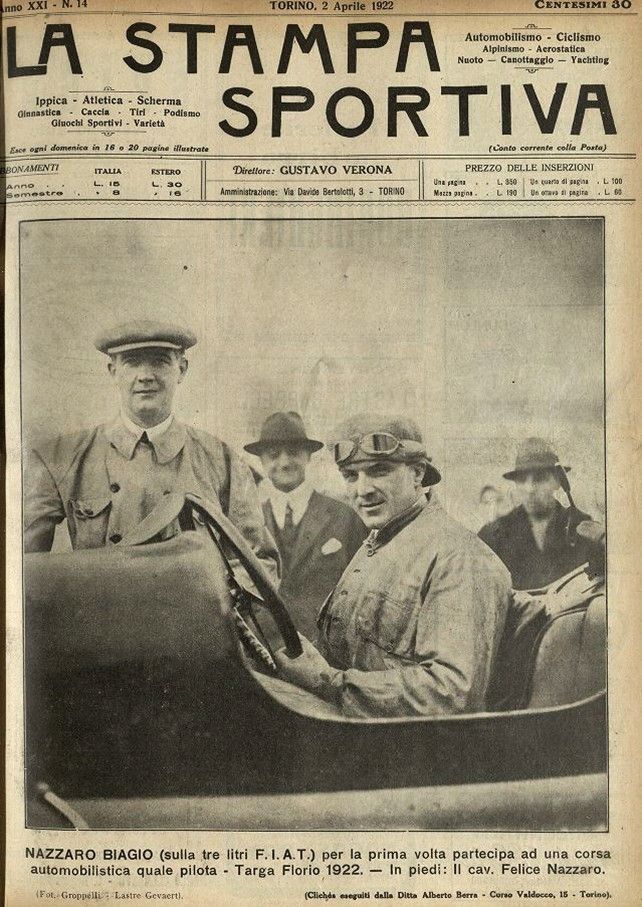
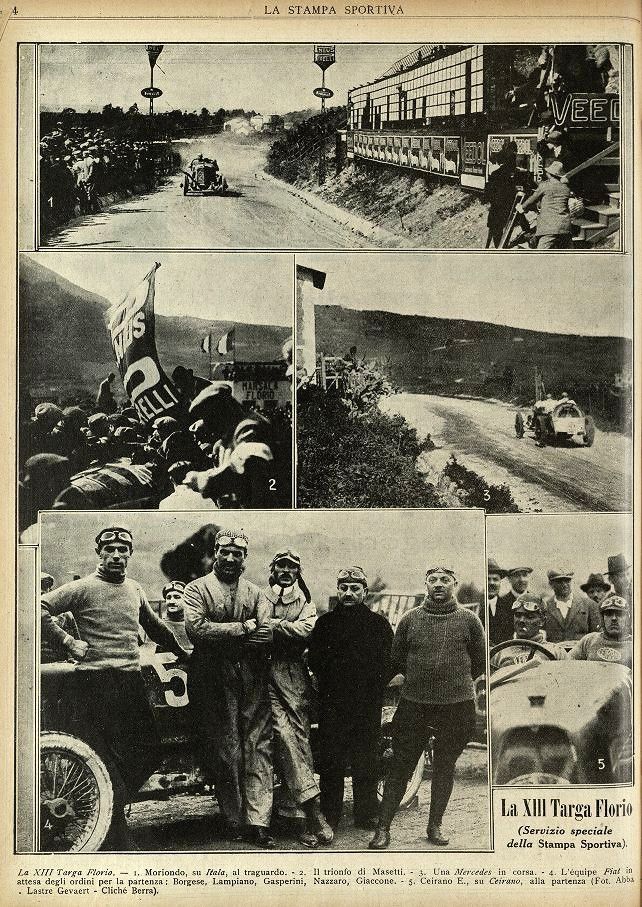
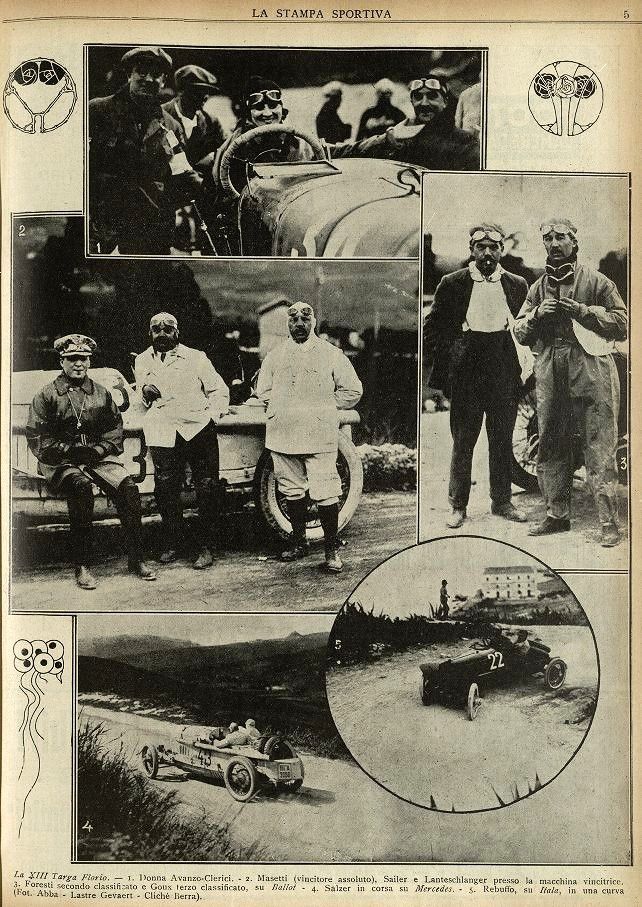
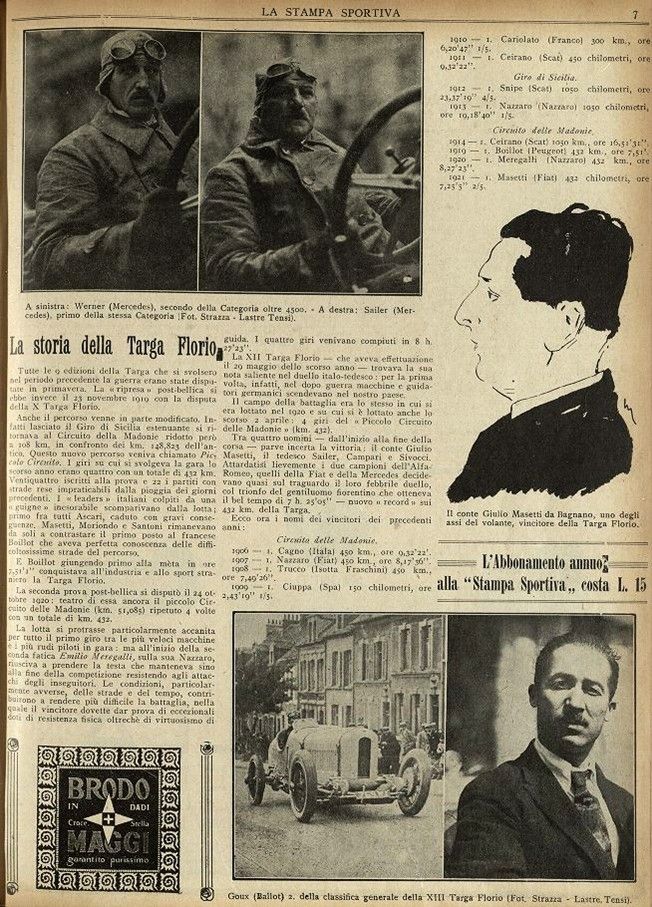
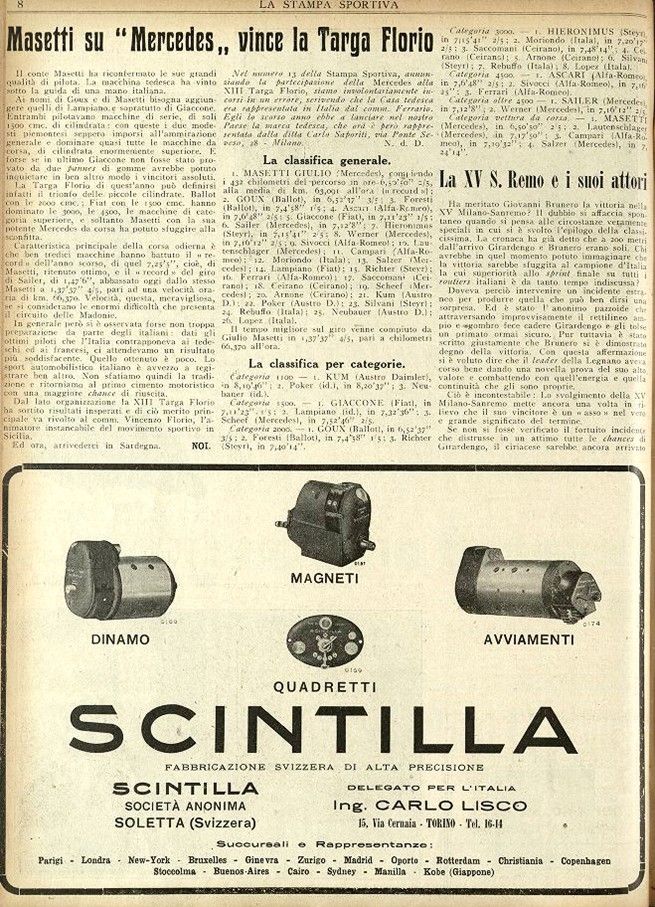
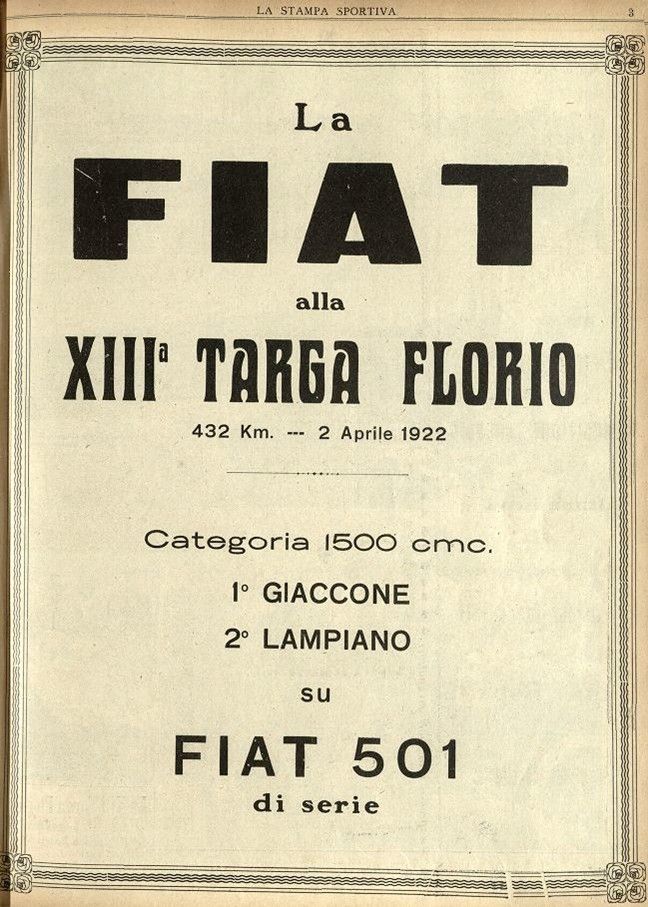
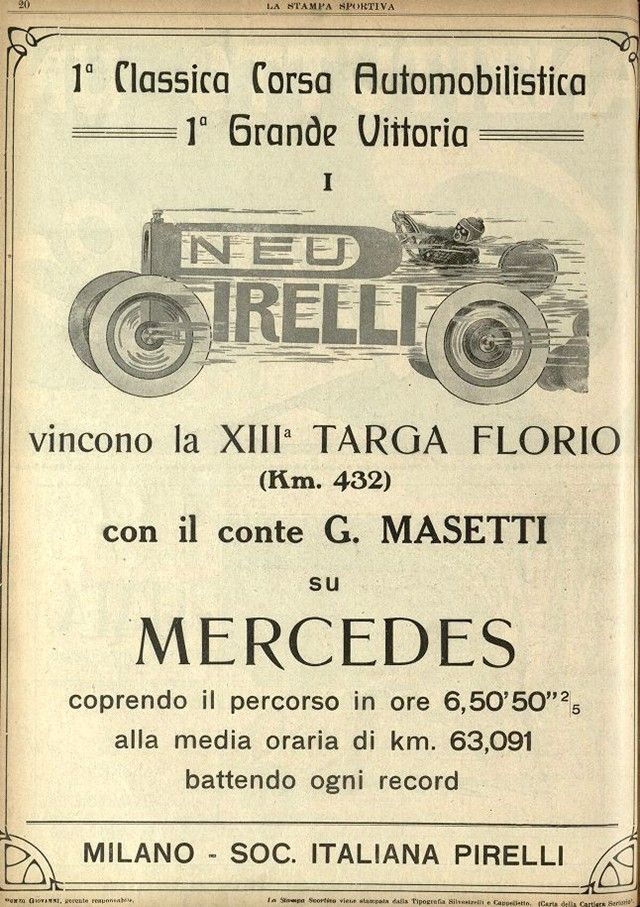
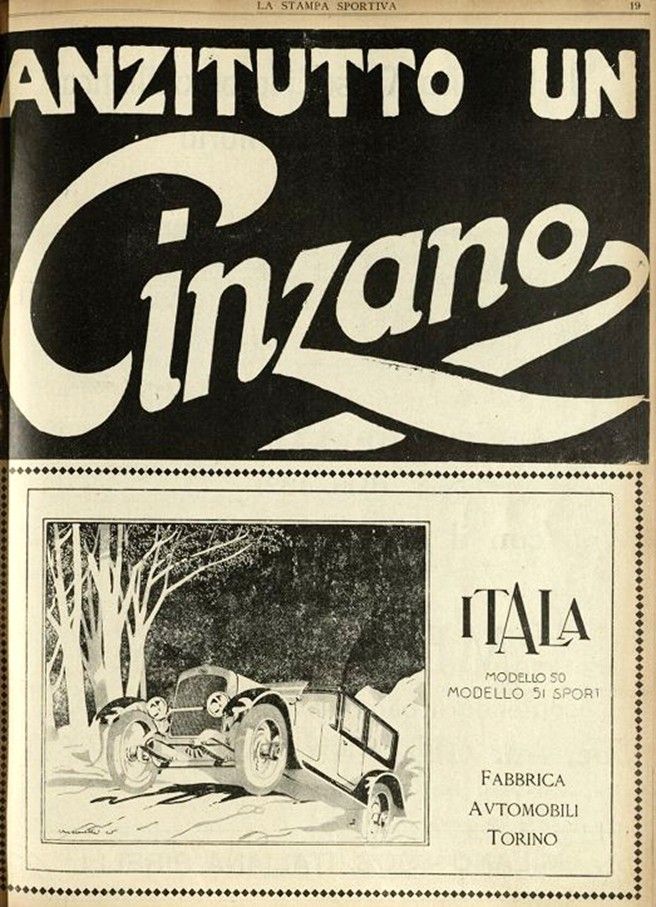
Text and fotos with courtesy of Museo dell’Automobile di Torino, byterfly.eu compiled by motorracinghistory.com
La Stampa Sportiva, Anno XXI, N. 15, Torino, 9 aprile 1922
NAZZARO BIAGIO (sulla tre litri F. I.A.T.) per la prima volta partecipa ad una corsa automobilistica quale pilota – Targa Florio 1922. — In piedi: Il cav. Felice Nazzaro.
(Fot.Groppelli – Lastre Gevaert). (Cliché» eseguiti dalla Ditta Alberto Berrà – Corso Valdocco, 15 – Torino).
La XIII Targa Florio (Servizio speciale della Stampa Sportiva)
La XIII Targa Florio. — 1. Moriondo, su Itala, al traguardo. – 2. Il trionfo di Masetti. – 3. Una Mercedes in corsa. – 4. L’équipe Fiat in attesa degli ordini per la partenza: Borgese, Lampiano, Gasperini, Nazzaro, Giaccone. – 5. Ceirano E., su Ceirano, alla partenza (Fot. Abba Lastre Gevaert – Cliché Berrà).
La XIII Targa Florio. – 1. Donna Avanzo-Clerici. – 2. Masetti (vincitore assoluto), Sailer e Lanteschlanger presso la macchina vincitrice 3. Foresti secondo classificato e Goux terzo classificato, su Ballot – 4. Salzer in corsa su Mercedes. – 5. Rebuffo, su Itala in una curva (Fot. Abba – Lastre Gevaert – Cliché Berrà).
La storia della Targa Florio
Tutte le 9 edizioni della Targa che si svolsero nel periodo precedente la guèrra erano state disputate in primavera. La «ripresa» post-bellica si ebbe invece il 23 novembre 1919 con la disputa della X Targa Florio.
Anche il percorso venne in parte modificato. Infatti, lasciato il Giro di Sicilia estenuante si ritornava al Circuito della Madonie ridotto però a 108 km. in confronto dei km. 148,823 dell’antico. Questo nuovo percorso veniva chiamato Piccolo Circtiito. I giri su cui si svolgeva la gara lo scorso anno erano quattro con un totale di 432 km. Ventiquattro iscritti alla prova, e 22 i partiti con strade rese impraticabili dalla pioggia dei giorni precedenti. I «leaders» italiani colpiti da una «guigne» inesorabile scomparivano dalla lotta, primo fra tutti Ascari, caduto con gravi conseguenze. Masetti, Moriondo e Santoni rimanevano da soli a contrastare il primo posto al francese Boillot che aveva perfetta conoscenza delle difficoltosissime strade del percorso.
E Boillot giungendo primo alla mèta in ore 7,5J’i“ conquistava all’industria e allo sport straniero la Targa Florio.
La seconda prova post-bellica si disputò il 24 ottobre 1920: teatro di essa ancora il piccolo Circuito delle Madonie (km. 51,085) ripetuto 4 volte con un totale di km. 432.
La lotta si protrasse particolarmente accanita per tutto il primo giro tra le più veloci macchine e i più rudi piloti in gara: ma all’inizio della seconda fatica Emilio Meregalli sulla sua Nazzaro, riusciva a prendere la testa che manteneva sino alla fine della competizione resistendo agli attacchi degli inseguitori. Le condizioni, particolarmente avverse, delle strade e del tempo, contribuirono a rendere più difficile la battaglia, nella quale il vincitore dovette dar prova di eccezionali doti di resistenza fisica oltreché di virtuosismo di guida. I quattro giri venivano compiuti in 8 h. 27’23“.
La XII Targa Florio — che aveva effettuazione il 29 maggio dello scorso anno — trovava la sua nota saliente nel duello italo-tedesco : per la prima volta, infatti, nel dopo guerra macchine e guidatori germanici scendevano nel nostro paese.
Il campo della battaglia era lo stesso in cui si era lottato nel 1920 e su cui si è lottato anche lo scorso 2 aprile: 4 giri del «Piccolo Circuito delle Madonie» (km. 432).
Tra quattro uomini — dall’inizio alla fine della corsa — parve incerta la vittoria: il conte Giulio Masetti, il tedesco Sailer, Campari e Sivocci. Attardatisi lievemente i due campioni dell’Alfa-Romeo, quelli della Fiat e della Mercedes decidevano quasi sul traguardo il loro febbrile duello, col trionfo del gentiluomo fiorentino che otteneva il bel tempo di 7 h. 25’05“ — nuovo «record» sui 432 km. della Targa.
Ecco ora i nomi dei vincitori dei precedenti anni:
Circuito, delle Madonie.
1906 — 1. Cagno (Itala) 450 km., ore 9,32’22“.
1907 — 1. Nazzaro (Fiat) 450 km., ore 8,17’36“.
1908 — 1. Trucco (Isotta Fraschini) 450 km., ore 7,49’26“
1909 — 1. Ciuppa (Spa) 150 chilometri, ore 2,43’19“ 1/5.
1910 — 1. Cariolato (Franco) 300 km., ore 6,20’47“ 1/5.
1911 — 1. Ceirano (Seat) 450 chilometri, ore 9,32’22“.
Giro di Sicilia.
1912 — 1. Snipe (Seat) 1050 chilometri, ore 23,37’19“ 4/5.
1913 — 1. Nazzaro (Nazzaro) 1050 chilometri, ore 19,18’40″1/5.
Circuito delle Madonie.
1914 — 1. Ceirano (Seat) 1050 lem., ore 16,51’31″.
1919 — 1. Boillot (Peugeot) 432 km., ore 7,51′.
1920 — 1. Meregalli (Nazzaro) 432 km., ore 8,27’23“.
1921 — 1. Masetti (Fiat) 432 chilometri, ore 7,25’5″ 2/5.
Foto.
Il conte Giulio Masetti da Bagnano, uno degli assi del volante, vincitore della Targa Florio.
A sinistra: Werner (Mercedes), secondo della Categoria oltre 4500. – A destra: Sailer (Mercedes), primo della stessa Categoria [Fot. Strazza – Lastre Tensi).
Goux (Ballot) 2. della classifica generale della XIII Targa Florio (Fot.
Pagina 8 – Masetti su „Mercedes„ vince la Targa Florio
Il conte Masetti ha riconfermato le sue grandi (qualità di pilota. La macchina tedesca ha vinto sotto la guida di una mano italiana.
Ai nomi di Goux e di Masetti bisogna aggiungere quelli di Lampiano. e soprattutto di Giaccone. Entrambi pilotavano macchine di serie, di soli 1500 cmc. di cilindrata: con queste i due modesti piemontesi seppero imporsi, all’ammirazione generale e dominare quasi tutte le macchine da corsa, di cilindrata enormemente superiore. E forse se in ultimo Giaccone non fosse stato provato da due panne di gomme avrebbe potuto inquietare in ben altro modo i vincitori assoluti.
La Targa Florio di quest’anno può definirsi infatti il trionfo delle piccole cilindrate. Ballot i con le 2000 cmc.; Fiat con le 1500 cmc. hanno dominato le 3000, le 4500, le macchine di categoria superiore, e soltanto Masetti con la sua potente Mercedes da corsa ha potuto sfuggire alla sconfitta.
Caratteristica principale della corsa odierna è che ben tredici macchine hanno battuto il «record» dell’anno scorso, di quel 7,25’5″, cioè, di Musetti, ritenuto ottimo, e il «record» del giro di Sailer, di 1,47’6″, abbassato oggi dallo stesso Masetti a 1,37’37“ 4/5, pari ad una velocità oraria di km. 66,370. Velocità, questa, meravigliosa, se si considerano le enormi difficoltà che presenta il circuito delle Madonie.
In generale però si è osservata forse non troppa preparazione da parte degli italiani: dati gli ottimi piloti che l’Italia contrapponeva ai tedeschi ed ai francesi, ci attendevamo un risultato più soddisfacente. Quello ottenuto è poco. Lo sport automobilistico italiano è avvezzo a registrare ben altro. Non sfatiamo quindi la tradizione e ritorniamo al primo cimento motoristico con una maggiore chance di riuscita.
Dal lato organizzazione la XIII Targa Florio ha sortito risultati insperati e di ciò merito principale va rivolto al comm. Vincenzo Florio, l’animatore instancabile del movimento sportivo in Sicilia.
Ed ora, arrivederci in Sardegna. NOI.
Nel numero 13 della Stampa Sportiva, annunziando la partecipazione della Mercedes alla XIII Targa Florio, siamo involontariamente incorsi in un errore, scrivendo che la Casa tedesca era rappresentata in Italia dal comm. Ferrarlo. Egli lo scorso anno ebbe a lanciare nel nostro Paese la marca tedesca, che ora è però rappresentata dalla ditta Carlo Saporiti, via Ponte Seveso, 28 – Milano. N. d. D.
La classifica generale.
1. MASETTI GIULIO (Mercedes), compiendo i 432 chilometri dei percorso in ore, 6,50’50“ 2/5, alla media di km. 63,091 all’ora (“record”); 2. GOUX (Ballot), in 6,52’37“ 3/5; 3. Foresti (Ballot), in 7,4’58″ 1/5 ; 4. Ascari (Alfa-Romeo), in 7,6’48″ 2/5; 5. Giaccone (Fiat), in 7,11’23“ 1/5; 6. Sailer (Mercedes), in 7,12’8″; 7. Hieronimus (Steyr), in 7,15’41“ 2/5; 8. Werner (Mercedes), in 7,16’12“ 2/5; 9. Sivocci (Alfa-Romeo); 10. Lautenschlager (Mercedes); 11. Campari (Alfa-Romeo); 12. Moriondo (Itala); 13. Salzer (Mercedes); 14. Lampiano (Fiat); 15. Richter (Steyr); 16. Ferrari (Alfa-Romeo); 17. Saccomani (Ceirano); 18. Ceirano (Ceirano); 19. Scheef iMer-cedés); 20. Arnone (Ceirano); 21. Kum (Austro D.); 22. Poker (Austro D.); 23. Silvani (Steyr); 24. Rebuffo (Itala); 25. Neubauer (Austro D.); 26. Lopez (Itala).
Il temilo migliore sul giro venne compiuto da Giulio Masetti in 1,37’37″ 4/5, pari a chilometri 66,370 all’ora.
La classifica per categorie.
Categoria 1100 — 1. KUM (Austro Daimler), in 8,10’46“; 2. Poker (id.), in 8,20’37“; 3. Neubauer (id.).
Categoria 1500. — 1. GIACCONE (Fiat), in 7,11 ’23“ 1/5; 2. Lampiano (id.), in 7,32’36“, 3. Schéef (Mercedes), in 7,52’40“ 2/5.
Categoria 2000. — 1. GOUX (Ballot), in 6,52’37“ 3/5; 2. Foresti (Ballot), in 7,4’58″ C5; 3. Richter (Steyr), in 7,40’14″.
Categoria 3000. — 1. HIERON1MUS (Steyr in 7; 15’41” 2/5; 2. Moriondo (Itala), in 7,20’1” 2/5; 3. Saccomani (Ceirano), in 7,48’14“; 4. Ceiranò (Ceirano); 5. Arnone (Ceirano); 6. Silvani (Steyr); 7. Rebuffo (Itala); 8. Lopez (Itala).
Categoria 4500. — 1. ASCARI (Alfa-Romeo) in 7,6’48“ 2/5; 2. Sivocci (Alfa-Romeo), in 7,16′. 25″; 3. Ferrari (Alfa-Romeo).
Categoria oltre 4500 — 1. SAILER (Mercedes) in 7,12’8″; 2. Werner (Mercedes), in 7,16’12″ 2/5′
Categoria vettura da corsa. — 1. MASETTÌ (Mercedes), in 6,50’50″ 2/5; 2. Lautenschlager (Mercedes), in 7,17’50″; 3. Campari (Alfa-Romeo), in 7,19’32″; 4. Salzer (Mercedes), in 7 24’4″.
Translation by DeepL.com 20.04.2025 (Cliché ~ foto)
NAZZARO BIAGIO (in a three-litre F.I.A.T.) takes part in a motor race for the first time as a driver – Targa Florio 1922. — Standing: Cav. Felice Nazzaro.
(Photo: Groppelli – Gevaert plates). (Clichés taken by Alberto Berrà – Corso Valdocco, 15 – Turin).
The XIII Targa Florio (Special report by Stampa Sportiva)
The 13th Targa Florio. — 1. Moriondo, in an Itala, at the finish line. – 2. Masetti’s triumph. – 3. A Mercedes in the race. – 4. The Fiat team waiting for the start: Borgese, Lampiano, Gasperini, Nazzaro, Giaccone. – 5. Ceirano E., in Ceirano, at the start (Photo: Abba Lastre Gevaert – Cliché Berrà).
The 13th Targa Florio. – 1. Donna Avanzo-Clerici. – 2. Masetti (overall winner), Sailer and Lanteschlanger with the winning car. 3. Foresti in second place and Goux in third place, in a Ballot. – 4. Salzer racing in a Mercedes. – 5. Rebuffo, in an Itala on a bend (Photo: Abba – Lastre Gevaert – Cliché Berrà).
Page 7 The history of the Targa Florio
All nine editions of the Targa that took place before the war were held in the spring. The post-war “revival” took place on November 23, 1919, with the tenth Targa Florio.
The route was also partially modified. In fact, after leaving the grueling Giro di Sicilia, the race returned to the Madonie Circuit, which had been reduced to 108 km compared to the 148.823 km of the old circuit. This new route was called the Piccolo Circtiito. Last year, the race consisted of four laps for a total of 432 km. Twenty-four riders registered for the race, and 22 started, with the roads rendered impassable by the rain of the previous days. The Italian leaders were struck by an inexorable streak of bad luck and disappeared from the race, first among them Ascari, who fell with serious consequences. Masetti, Moriondo, and Santoni remained alone to challenge the Frenchman Boillot for first place, who had perfect knowledge of the extremely difficult roads of the route.
Boillot crossed the finish line first in 7 hours, 5 minutes and 10 seconds, winning the Targa Florio for Italian industry and sport.
The second post-war race was held on October 24, 1920, once again on the small Madonie Circuit (51.085 km), repeated four times for a total of 432 km.
The battle was particularly fierce throughout the first lap between the fastest cars and the toughest drivers in the race, but at the start of the second lap, Emilio Meregalli in his Nazzaro managed to take the lead, which he maintained until the end of the competition, resisting the attacks of his pursuers. The particularly adverse road and weather conditions contributed to making the battle even more difficult, in which the winner had to demonstrate exceptional physical endurance as well as driving virtuosity. The four laps were completed in 8 hours, 27 minutes, and 23 seconds.
The 12th Targa Florio, which took place on May 29 last year, was notable for the Italian-German duel: for the first time since the war, German cars and drivers competed in our country.
The battlefield was the same as in 1920 and on 2 April this year: four laps of the „Small Circuit of the Madonie“ (432 km).
From start to finish, the victory seemed uncertain between four men: Count Giulio Masetti, the German Sailer, Campari, and Sivocci. The two Alfa Romeo champions lagged slightly behind, while those from Fiat and Mercedes decided their feverish duel almost at the finish line, with the triumph of the Florentine gentleman who achieved a fine time of 7 h 2′ 22” — a new ‘record’ for the 432 km of the Targa.
Here are the names of the winners from previous years:
Madonie Circuit.
1906 — 1. Cagno (Itala) 450 km, 9 hours, 32 minutes, 22 seconds.
1907 — 1. Nazzaro (Fiat) 450 km, 8 hours, 17 minutes, 36 seconds.
1908 — 1. Trucco (Isotta Fraschini) 450 km, 7 hours, 49 minutes, 26 seconds
1909 — 1. Ciuppa (Spa) 150 kilometers, 2 hours, 43 minutes, 19 seconds
1910 — 1. Cariolato (Franco) 300 km, 6 hours, 20 minutes and 47 seconds 1/5.
1911 — 1. Ceirano (Seat) 450 kilometers, 9 hours, 32 minutes and 22 seconds.
Tour of Sicily.
1912 — 1. Snipe (Seat) 1050 kilometers, time 23 hours, 37 minutes, 19 seconds, 4/5.
1913 — 1. Nazzaro (Nazzaro) 1050 kilometers, time 19 hours, 18 minutes, 40 seconds, 1/5.
Madonie Circuit.
1914 — 1st Ceirano (Seat) 1050 km, 16:51:31.
1919 — 1st Boillot (Peugeot) 432 km, 7:51.
1920 — 1st Meregalli (Nazzaro) 432 km, 8:27:23.
1921 — 1st Masetti (Fiat) 432 kilometers, 7 hours, 25 minutes, 5 seconds 2/5.
Photos.
Count Giulio Masetti from Bagnano, one of the stars of the wheel, winner of the Targa Florio.
Left: Werner (Mercedes), second in the over 4500 category. Right: Sailer (Mercedes), first in the same category [Photo: Strazza – Lastre Tensi). Goux (Ballot) 2nd in the overall classification of the 13th Targa Florio (Photo:
Page 8 Masetti wins the Targa Florio in a Mercedes
Count Masetti has once again confirmed his great driving skills. The German car won under Italian guidance.
To the names of Goux and Masetti, we must add those of Lampiano and, above all, Giaccone. Both were driving standard cars with only 1500 cc engines: with these, the two modest Piedmontese drivers were able to impose themselves, to the general admiration, and dominate almost all the racing cars with vastly superior engines. And perhaps if Giaccone had not been hampered by two punctures, he might have caused the overall winners much more trouble.
This year’s Targa Florio can in fact be described as a triumph for small engines. Ballot with 2000 cc and Fiat with 1500 cc dominated the 3000 and 4500 cc cars in the higher categories, and only Masetti with his powerful Mercedes racing car was able to escape defeat.
The main feature of today’s race is that thirteen cars beat last year’s ‚record‘ of 7:25.5, set by Musetti, which was considered excellent, and Sailer’s lap ‚record‘ of 1:47.6, which was lowered today by Masetti himself to 1:37.37 4/5, equal to a speed of 66.370 km/h. This is a wonderful speed, considering the enormous difficulties presented by the Madonie circuit.
In general, however, the Italians did not seem to be particularly well prepared: given the excellent drivers that Italy fielded against the Germans and the French, we expected a more satisfactory result. What we got was not much. Italian motor racing is used to much better results. Let us not break with tradition, therefore, and return to the first motor racing event with a better chance of success.
From an organizational point of view, the 13th Targa Florio produced unexpected results, and the main credit for this must go to Comm. Vincenzo Florio, the tireless promoter of motor sport in Sicily.
And now, see you in Sardinia. NOI.
In issue 13 of Stampa Sportiva, announcing Mercedes‘ participation in the 13th Targa Florio, we inadvertently made a mistake, writing that the German manufacturer was represented in Italy by Comm. Ferrarlo. Last year, he launched the German brand in our country, but it is now represented by Carlo Saporiti, Via Ponte Seveso, 28 – Milan. Editor’s note.
The overall classification.
1. MASETTI GIULIO (Mercedes), completing the 432 kilometers of the course in 6 hours, 50 minutes and 50 seconds, at an average speed of 63.091 km/h (a “record”);
2. GOUX (Ballot), in 6,52’373/5; 3. Foresti (Ballot), in 7.4’58“ 1/5 ; 4. Ascari (Alfa-Romeo), in 7.6’48” 2/5; 5. Giaccone (Fiat), in 7.11’23” 1/5; 6. Sailer (Mercedes), in 7:12:8; 7. Hieronimus (Steyr), in 7:15:41 2/5; 8. Werner (Mercedes), in 7:16:12 2/5; 9. Sivocci (Alfa-Romeo); 10. Lautenschlager (Mercedes); 11. Campari (Alfa-Romeo); 12. Moriondo (Itala); 13. Salzer (Mercedes); 14. Lampiano (Fiat); 15. Richter (Steyr); 16. Ferrari (Alfa-Romeo); 17. Saccomani (Ceirano); 18. Ceirano (Ceirano); 19. Scheef iMer-cedés); 20. Arnone (Ceirano); 21. Kum (Austro D.); 22. Poker (Austro D.); 23. Silvani (Steyr); 24. Rebuffo (Itala); 25. Neubauer (Austro D.); 26. Lopez (Itala).
The best lap time was achieved by Giulio Masetti in 1:37:37 4/5, equal to 66.370 kilometers per hour.
The classification by category.
Category 1100 — 1. KUM (Austro Daimler), in 8:10:46; 2. Poker (id.), in 8:20:37; 3. Neubauer (id.).
Category 1500 — 1. GIACCONE (Fiat), in 7:11:23 1/5; 2. Lampiano (id.), in 7:32:36, 3. Schéef (Mercedes), in 7:52:40 2/5.
Category 2000. — 1. GOUX (Ballot), in 6:52:37 3/5; 2. Foresti (Ballot), in 7:4:58 C5; 3. Richter (Steyr), in 7:40:14.
Category 3000. — 1. HIERON1MUS (Steyr in 7; 15’41“ 2/5; 2. Moriondo (Itala), in 7.20’1” 2/5; 3. Saccomani (Ceirano), in 7.48’14”; 4. Ceiranò (Ceirano); 5. Arnone (Ceirano); 6. Silvani (Steyr); 7. Rebuffo (Itala); 8. Lopez (Itala).
Category 4500. — 1. ASCARI (Alfa-Romeo) in 7:06:48 2/5; 2. Sivocci (Alfa-Romeo), in 7:16. 25“; 3. Ferrari (Alfa-Romeo).
Category over 4500 — 1. SAILER (Mercedes) in 7:12:8”; 2. Werner (Mercedes), in 7:16:12 2/5′ Racing car category. — 1. MASETTÌ (Mercedes), in 6.50’50“ 2/5; 2. Lautenschlager (Mercedes), in 7.17’50”; 3. Campari (Alfa-Romeo), in 7.19’32“; 4. Salzer (Mercedes), in 7 24’4”.
